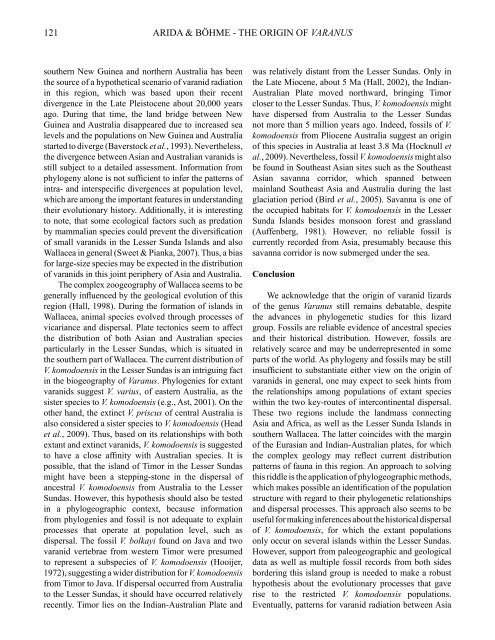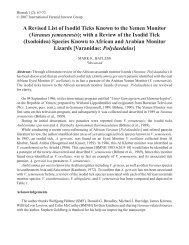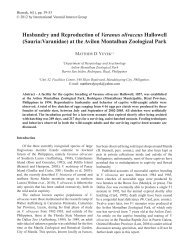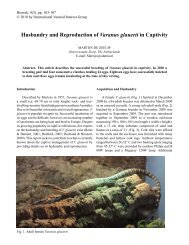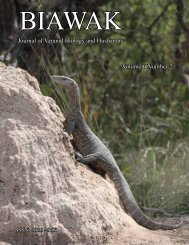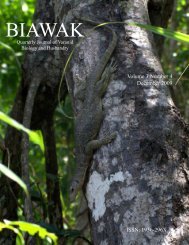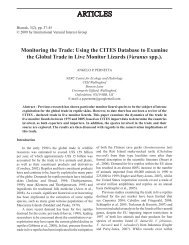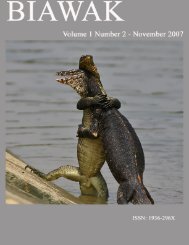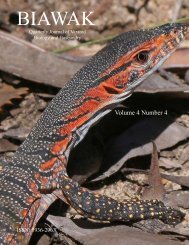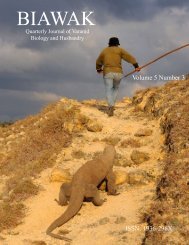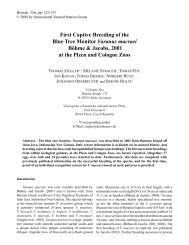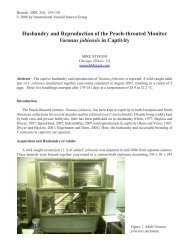BIAWAK - International Varanid Interest Group
BIAWAK - International Varanid Interest Group
BIAWAK - International Varanid Interest Group
- No tags were found...
Create successful ePaper yourself
Turn your PDF publications into a flip-book with our unique Google optimized e-Paper software.
121<br />
ARIDA & BÖHME - THE ORIGIN OF VARANUS<br />
southern New Guinea and northern Australia has been<br />
the source of a hypothetical scenario of varanid radiation<br />
in this region, which was based upon their recent<br />
divergence in the Late Pleistocene about 20,000 years<br />
ago. During that time, the land bridge between New<br />
Guinea and Australia disappeared due to increased sea<br />
levels and the populations on New Guinea and Australia<br />
started to diverge (Baverstock et al., 1993). Nevertheless,<br />
the divergence between Asian and Australian varanids is<br />
still subject to a detailed assessment. Information from<br />
phylogeny alone is not sufficient to infer the patterns of<br />
intra- and interspecific divergences at population level,<br />
which are among the important features in understanding<br />
their evolutionary history. Additionally, it is interesting<br />
to note, that some ecological factors such as predation<br />
by mammalian species could prevent the diversification<br />
of small varanids in the Lesser Sunda Islands and also<br />
Wallacea in general (Sweet & Pianka, 2007). Thus, a bias<br />
for large-size species may be expected in the distribution<br />
of varanids in this joint periphery of Asia and Australia.<br />
The complex zoogeography of Wallacea seems to be<br />
generally influenced by the geological evolution of this<br />
region (Hall, 1998). During the formation of islands in<br />
Wallacea, animal species evolved through processes of<br />
vicariance and dispersal. Plate tectonics seem to affect<br />
the distribution of both Asian and Australian species<br />
particularly in the Lesser Sundas, which is situated in<br />
the southern part of Wallacea. The current distribution of<br />
V. komodoensis in the Lesser Sundas is an intriguing fact<br />
in the biogeography of Varanus. Phylogenies for extant<br />
varanids suggest V. varius, of eastern Australia, as the<br />
sister species to V. komodoensis (e.g., Ast, 2001). On the<br />
other hand, the extinct V. priscus of central Australia is<br />
also considered a sister species to V. komodoensis (Head<br />
et al., 2009). Thus, based on its relationships with both<br />
extant and extinct varanids, V. komodoensis is suggested<br />
to have a close affinity with Australian species. It is<br />
possible, that the island of Timor in the Lesser Sundas<br />
might have been a stepping-stone in the dispersal of<br />
ancestral V. komodoensis from Australia to the Lesser<br />
Sundas. However, this hypothesis should also be tested<br />
in a phylogeographic context, because information<br />
from phylogenies and fossil is not adequate to explain<br />
processes that operate at population level, such as<br />
dispersal. The fossil V. bolkayi found on Java and two<br />
varanid vertebrae from western Timor were presumed<br />
to represent a subspecies of V. komodoensis (Hooijer,<br />
1972), suggesting a wider distribution for V. komodoensis<br />
from Timor to Java. If dispersal occurred from Australia<br />
to the Lesser Sundas, it should have occurred relatively<br />
recently. Timor lies on the Indian-Australian Plate and<br />
was relatively distant from the Lesser Sundas. Only in<br />
the Late Miocene, about 5 Ma (Hall, 2002), the Indian-<br />
Australian Plate moved northward, bringing Timor<br />
closer to the Lesser Sundas. Thus, V. komodoensis might<br />
have dispersed from Australia to the Lesser Sundas<br />
not more than 5 million years ago. Indeed, fossils of V.<br />
komodoensis from Pliocene Australia suggest an origin<br />
of this species in Australia at least 3.8 Ma (Hocknull et<br />
al., 2009). Nevertheless, fossil V. komodoensis might also<br />
be found in Southeast Asian sites such as the Southeast<br />
Asian savanna corridor, which spanned between<br />
mainland Southeast Asia and Australia during the last<br />
glaciation period (Bird et al., 2005). Savanna is one of<br />
the occupied habitats for V. komodoensis in the Lesser<br />
Sunda Islands besides monsoon forest and grassland<br />
(Auffenberg, 1981). However, no reliable fossil is<br />
currently recorded from Asia, presumably because this<br />
savanna corridor is now submerged under the sea.<br />
Conclusion<br />
We acknowledge that the origin of varanid lizards<br />
of the genus Varanus still remains debatable, despite<br />
the advances in phylogenetic studies for this lizard<br />
group. Fossils are reliable evidence of ancestral species<br />
and their historical distribution. However, fossils are<br />
relatively scarce and may be underrepresented in some<br />
parts of the world. As phylogeny and fossils may be still<br />
insufficient to substantiate either view on the origin of<br />
varanids in general, one may expect to seek hints from<br />
the relationships among populations of extant species<br />
within the two key-routes of intercontinental dispersal.<br />
These two regions include the landmass connecting<br />
Asia and Africa, as well as the Lesser Sunda Islands in<br />
southern Wallacea. The latter coincides with the margin<br />
of the Eurasian and Indian-Australian plates, for which<br />
the complex geology may reflect current distribution<br />
patterns of fauna in this region. An approach to solving<br />
this riddle is the application of phylogeographic methods,<br />
which makes possible an identification of the population<br />
structure with regard to their phylogenetic relationships<br />
and dispersal processes. This approach also seems to be<br />
useful for making inferences about the historical dispersal<br />
of V. komodoensis, for which the extant populations<br />
only occur on several islands within the Lesser Sundas.<br />
However, support from paleogeographic and geological<br />
data as well as multiple fossil records from both sides<br />
bordering this island group is needed to make a robust<br />
hypothesis about the evolutionary processes that gave<br />
rise to the restricted V. komodoensis populations.<br />
Eventually, patterns for varanid radiation between Asia


